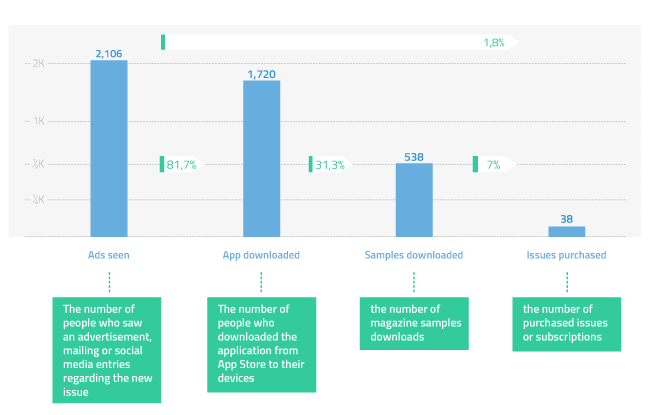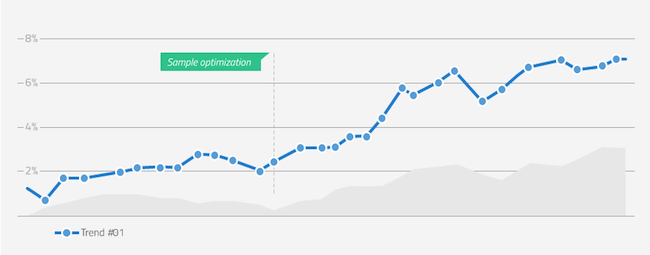If you think of sales funnels as a piece of kitchenware and do not see a bigger connection between them and your magazine on the iPad, this article is for you.
The idea of funnels is widely known in marketing and in areas connected with sales. Marketers evaluating the efficiency of their campaigns use funnels. Likewise, salesmen use them to assess their efficiency as well. Even support teams measure their progress by looking at funnels.
In a nutshell, a funnel is a percentage value of the conversion from one step of the process to the other one. For instance, if my application gets downloaded by 1000 people on their iPads, I am interested in how many of them actually opens it on their device (fun fact: it’s not 100%).
What Should Mobile Magazine Publishers Measure?
The most obvious sales funnel is the amount of downloaded applications on the iPad/iPhone and then the conversion to purchased issues. Each publisher should observe this funnel a few times a month and check whether the marketing actions he or she takes have any impact on sales.
This is however not the only sales funnel that can be built for magazines on the iPad. More advanced funnel is:
- The number of people who saw an advertisement, mailing or social media entries regarding the new issue
- The number of people who downloaded the application from App Store to their devices
- The number of magazine samples downloads
- The number of purchased issues or subscriptions
Why Look at Sales Funnels Instead of Observing the Sales Alone?
Observing the sales itself cannot answer where the users are dropping out and which stage of the sales process is not working. For example, an ideal funnel described above could look like that:

As we can see, a number of people approach the application after advertising campaigns, many of them download a free sample of the magazine but in turn, only a small number buys the whole issue. Why?
Observing the sales values alone will not suggest where the bottleneck of the sales process lies and where the customers are dropping out. In turn, after seeing the above graph, a clever publisher can focus on solving the problem of converting free samples to paid magazines.
The content of free issues might be chosen incorrectly. They might be too short (or too long). Or perhaps they should include a clear suggestion of purchasing the full issue on the last page?
After evaluating each option, the publisher should have another look at the sales funnel and observe the trend. If, for instance, after changing the length of the samples, the conversion trend saw an increase, it means that everything is going well. And so on.

The graph shows an example trend of converting free magazines into full issues over the last 30 days. It clearly shows that in one point, a change for the better occurred. It is the moment at which the publisher focused on optimizing his samples.
Good Practices When Working with Funnels
- You can create a large number of funnels, however it is worth having only 2-3 most important ones before your eyes.
- Remember that each channel of canvassing customers can have its own funnel. For example: if from the 1st to the 15th day of the month you have your AdWords advertisement campaign running, while from the 16th to the 30th you are sending newsletters introducing the new issue, you should clearly split these two periods into two funnels – advertising and emailing. Thanks to that, you can assess each of the channels correctly, and estimate the cost of winning the reader over, for example.
- Sometimes it is worth choosing only one fragment of the sales funnel and focusing on it for a couple of weeks. If you feel that your marketing campaigns are working well, test the conversions on another stages.
- Each team member should have access to their fragment of the funnel. The marketing team should see the conversion from advertising to application downloads. The editorial staff and cover designers should know who downloads free issues and buys the full ones. The person responsible for business should look at how pricing changes influent the conversion.
- If you feel that your sales funnel is already optimised well, you might want to focus on adding more people to the top of it. At the end of the day, in order to increase sales twofold, you need to have twice the number of people in the beginning of the funnel. The rest is pure mathematics.
Bonus: Inverting the sales Funnel
Sometimes it is worth going beyond the scheme when analysing the funnel. If you feel that your funnel is alreading doing good, think about how to get one reader to bring the next one. Thanks to that, it might turn out that on some stage, a funnel will have a conversion rate higher than 100%!
The second thing publishers often forget is retention. If a reader has paid you for your content in the past once, she is highly likely to buy the next issue. This is why it is worth taking time to optimise the conversion to subscribers.
On PressPad, the publishers have access to detailed sales data and their magazine downloads. Possession of such data allows for building funnels and optimising sales processes. Get your magazine to the App Store for free with PressPad.
These articles from our blog may help you with funnel optimization:

